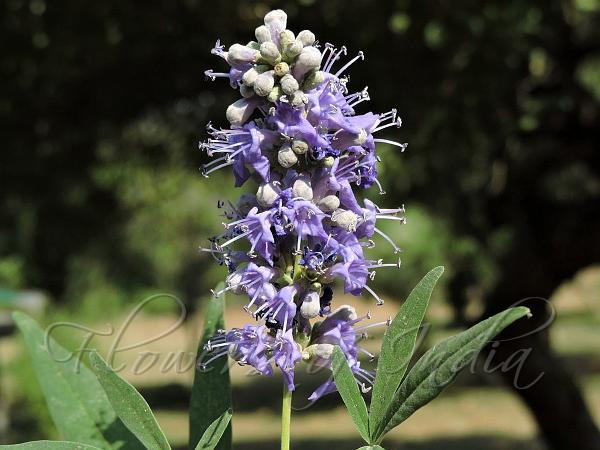|
| Chasteberry |
|

|

|
|
|
|
Photo: |
Botanical name: Vitex agnus-castus Family: Verbenaceae (Verbena family)
Synonyms: Agnus-castus vulgaris, Vitex agnus, Vitex integra, Vitex lupinifolia
Synonyms: Agnus-castus vulgaris, Vitex agnus, Vitex integra, Vitex lupinifolia
Chasteberry is a deciduous shrub, 1-5 m tall. Leaves
aare digitately compound, with leaflets 5-7, aromatic,
narrowly-lanceshaped, stalked, hairless above and white-woolly beneath
with tomentum obscuring the whole lower surface. Flowers are borne at
branch-ends, in spike-like clusters, comprised of many-flowered cymes
in narrow panicles, usually with additional spike-like inflorescences
from the axils of the upper leaves. Flowers are small, pale violet,
fragrant, 4 mm across. Sepal-cup is 3 mm long, 2 mm broad, bell-shaped,
flat, triangulate to obscurely toothed, persistent. Flowers are 7-10 mm
long, exceeding the sepal-cup; lower lobes hairless to slightly
velvet-hairy at the base. Chasteberry fruit is spherical, 2-2.5 mm in
diameter, protruding half-way above the slightly enlarged and expanded,
persistent sepal-cup, hairless. Chasteberry is native to the
Mediterranean region to Pakistan. Flowering: May-July.
Medicinal uses: The leaves and tender stem
growth of the upper 10 cm (3.9 in), along with the flowers and ripening
seeds, are harvested for alternative medicinal purposes. It is
believed the berries are a tonic herb for both the male and female
reproductive systems. Despite numerous studies, there is limited
clinical evidence for the effectiveness of vitex plant extracts to
manage premenstrual stress syndrome, including premenstrual dysphoric
disorder.
The leaves and tender stem
growth of the upper 10 cm (3.9 in), along with the flowers and ripening
seeds, are harvested for alternative medicinal purposes. It is
believed the berries are a tonic herb for both the male and female
reproductive systems. Despite numerous studies, there is limited
clinical evidence for the effectiveness of vitex plant extracts to
manage premenstrual stress syndrome, including premenstrual dysphoric
disorder.
Medicinal uses:
 The leaves and tender stem
growth of the upper 10 cm (3.9 in), along with the flowers and ripening
seeds, are harvested for alternative medicinal purposes. It is
believed the berries are a tonic herb for both the male and female
reproductive systems. Despite numerous studies, there is limited
clinical evidence for the effectiveness of vitex plant extracts to
manage premenstrual stress syndrome, including premenstrual dysphoric
disorder.
The leaves and tender stem
growth of the upper 10 cm (3.9 in), along with the flowers and ripening
seeds, are harvested for alternative medicinal purposes. It is
believed the berries are a tonic herb for both the male and female
reproductive systems. Despite numerous studies, there is limited
clinical evidence for the effectiveness of vitex plant extracts to
manage premenstrual stress syndrome, including premenstrual dysphoric
disorder. | Identification credit: Anil Thakur | Photographed in cultivation in Panjab University, Chandigarh. |
• Is this flower misidentified? If yes,